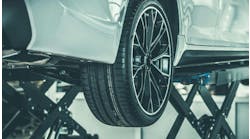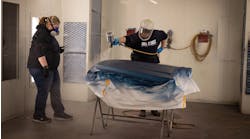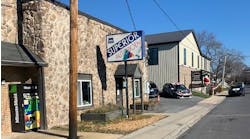Luis Gonzalez looked on as a technician, thinking of everything he would fix if given the opportunity to run LG Auto Body.
LG Auto Body
Locations: Silver Spring, Md.
Size: 8,000 square feet
Staff: 14
Average Monthly Car Count: 40
Annual Revenue: $1 million
Four years into his stint, at just 25, he was given that opportunity much sooner than expected: When the owner announced he was retiring and nobody was willing to buy the Silver Springs, Md., business, Gonzalez took a chance and bought the shop.
All of those changes Gonzalez wanted to make? From improving the scheduling process to eliminating comebacks to engaging effectively with customers to establishing open communication to forming a tight-knit team? He did it all, and his investment in the shop has paid off: Annual revenue has more than doubled over the past four years (now resting at $1 million), the comeback rate is right around 1 percent, and, as Gonzalez puts it, “we’re all one big family.”
Gonzalez credits that success to a strict daily routine that involves constant communication and updates between everyone in the shop.
Before, when we opened, everyone would get into the shop at the same time. I changed that. Now the office opens 30 minutes earlier, because we need to get a feel of the day before the technicians get into the shop. By the time they get in, we already have our schedule mapped out for the day. We already know what customers showed up and didn’t show up. We don’t waste time with the what-ifs. Those 30 minutes give us the chance to go through all of that.
We map out everything with Google calendar, which is how we all stay connected during work. Any notes we take on jobs, we’ll put on the calendar and mark what needs to be done. That way we don’t do anything twice. So if I’m on my computer checking the schedule and I see a new note because somebody called in about an estimate, I don’t have to be asking questions and wondering who’s coming in and what they need. Then when a customer pops in the office, any of us can take care of it right away by checking the notes.
Your Team is Your Biggest Asset
The team, I can tell you, is the biggest asset for any company. That’s why I treat them the way I treat them. I don’t try to be the boss—I try to be a friend, so they understand that they have a friend that can help with them solving issues.
That, in turn, makes everyone team-driven. If there’s a hiccup or we’re getting behind, the paint department will go back to the body guys and check if they need any help. If a tech sees an imperfection on the paint, he’ll go back to the painter and find a solution. They all have a common goal. They all know what I promise to the customer, and that’s exactly what they deliver.
On Mondays, we’ll have a morning meeting to go over the week’s work. I think we’re such a good team because we have very open communication at our meetings. I like to remind them, If there’s anything you see you think I’m doing wrong, I need to know. If you think of anything you think might work here, I’d like to implement it. I’m very open to ideas. If it’s going to improve our day and our outcome on the repair, why not?
We always try to move forward with everything and try to bring new things and change the process. If I see something that is not working, we try to evaluate it and change it. The industry is moving different directions at all times, and we have to move with the industry.
Sometimes, it feels like everyone will agree with everything you say. But I tell my guys to try to work with me. Don’t just agree with me—tell me I’m wrong and tell me why. Then we can analyze and discuss it. That’s very big for them because they know they have a voice in the shop and they can make a real difference.
Then we do the first of three walkarounds we’ll have throughout the day. We cover the entire process, from the parking lot to the body shop to paint shop to materials inventory—everything. I personally make sure everything is moving forward, inspect for quality, provide paperwork, restock their materials, and give my guys advice on jobs.
The first walkaround is at 8 a.m. The is the most important one. Everybody is already working and the shop is up and running. Myself, the DSR and the estimator walk through the entire shop. We each have a notepad and write down information about the cars: when car is leaving, what needs to be updated, if the insurance company needs to be called.
It is a very important part of our success, because it improves communication overall. If we note a change with a vehicle, we know what to say to the customer when he or she calls. If a part is going to be late. This way, we don’t want to find out about something later in the day. We have the time to fix any big issues.
When I’m not on the floor, I’m up front greeting customers. I split duties with my estimator: He handles the appointments, and I take the walk-ins. If he needs to go handle a supplement, then I’ll stay and take care of an appointment. And if I need to go into the shop, I bring him into the office to take any walk-ins.
I really love talking to customers—talking on the phone, writing estimates, talking to insurance companies. I’m always motivated and pumped to help out, and they see that on me. They see that I’m happy to help out. They don’t see someone who’s miserable. I may be down about something outside work or I might be sick, but I try not to show that. I try to be positive all the time, to smile and chat with them. That’s the way you gain their confidence. Even if they’re mad, that tone changes their demeanor.
If we miss something on the first walkaround, we see it the second walkaround at 12:30 p.m. Basically, we reinforce what we already saw in the morning. And if anything changes by then, we make notes. It’s very simple, and only takes about 10 minutes on each walkaround. But those 10 minutes save us a ton of work. We can make sure our day moves forward without having any problems.
When I’m on the floor, I try to come across as a friend, not a boss. And I will straight-up tell them that: They need to see me as a friend they can trust. When you have the bossy position, they're afraid to ask for things. But with my guys, because we have such great communication between everybody, if something happens, they don’t try to hide it. They just come to me and say, This happened, what can we do?
That is a huge part of our success, because when they have the confidence, they can work a lot better. Having that open communication makes everything flow better. They know they have say, but that I make the determination of what we’ll do with something. They know that making their own decisions might be affecting me and the rest of the shop. It’s better for me to find out what went wrong, versus the customer finding out something is messed up. That open communication has practically eliminated comebacks.
That open communication will spread beyond me and into the shop. If a tech sees an imperfection on the paint, he’s not afraid to head back to the paint department and talk about it. They all know what I promise to the customer and the quality that is demanded on every single job, and that can’t happen if they’re not being open with each other.
The 5:30 p.m. walkaround closes out the day. It is very important, because we go through what we’ve gotten done, what is late, what is coming in the next day. That way we also figure out our next day’s schedule with a technician. We also figure what needs to be done at what time the next day.




